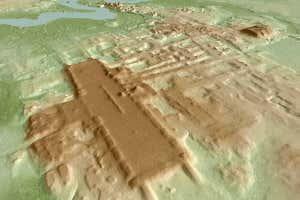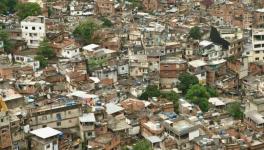Oldest and Largest Structure of Maya Civilisation Discovered in Mexico

The 3D Image of Aguada Fenix, Generated by Remote Sensing. Image Courtesy: New Scientist. Image is for representational use only.
The oldest and the largest monument built during the Maya civilisation has recently been discovered in Southern Mexico. The monument at the archaeological site of Aguada Fénix is a huge raised platform and looks like an artificial plateau itself. The Aguada Fenix measures about 1.4 kilometre in length, 399 metre in width, and 10-15 meter in height.
Led by Takeshi Inomata and Daniela Triadan of University of Arizona in Tucson, the findings were published in Nature on June 3.
Interestingly, Aguada Fenix was not something hidden deep in the forest, but lies on a cattle ranch situated in Tabasca of Mexico, near the Northwestern border of Guatemala. And hence, the site has remained hidden for so long.
Inomata and his colleagues resorted to a relatively new technique known as lidar (light detection and ranging) survey in which a plane having the equipment of lasers flies over a region and bombards the place beneath it with the lasers. The lasers can pass through even the dense vegetation and create a 3D map of a shape that lies hidden. The lidar survey revealed that there exists a huge structure like an artificial plateau with nine causeways radiating out of it. After the lidar survey, the researchers went on excavating the plateau to find out more about its construction. The team found that artifacts made of jade and stones, which probably were used in rituals in Aguada Fenix, were present at the site.
The new findings also changed the way researchers used to view the Maya civilisation. The traditional theory believes that the Maya civilisation developed between 1200-1000BC gradually. The survival of the Maya people were dependent on a combination of hunting, gathering and probably some farming, like that of maize. And it was not until 1000-350BC that the Maya people began to settle in small villages that accompanied creation of ceramics and henceforth a slow transit to a sedentary form.
Going by this theory, the Maya people did not start building centres for ceremonial purposes till 350-250BC.
The new findings have challenged this idea. The radiocarbon dating of 69 samples, as the study suggests, from the Aguada Fenix showed that it was in fact built somewhere between 1000-800BC. The site was largely abandoned by 750BC and hereafter, small groups returned for its use.
Another important aspect that needs a mention here is that Aguada Fenix is not the only huge artificial plateau and ceremonial centre that the Maya civilisation built. Till the new findings came out, what was considered to be the oldest such monument was the artificial plateau built at Ceibal in 950BC.
The significant inference that can be drawn from these is that Maya people built large structures much before civilisation started getting more organised and centralised governance emerged.
Inomata, the lead author and a professor of anthropology at University of Arizona at Tucson, was quoted to have said about the new findings: "It forced us to change our understanding of the development of Maya civilisation and the development of human society in general.”
The structure of the Aguada Fenix, as estimated by the team used some 3.2-4.3 million cubic meters of earth and for building such a huge structure, thousands of people’s labour must have been required According to Daniela Triadan, the co-lead author of the study, Aguada Fenix could have been built by the semi-nomadic people that lived nearby. “The whole construction itself seems to be this communal open space,” says Triadan. She also says that the monument has no signs that could suggest that it was built for a powerful ruling class.
Get the latest reports & analysis with people's perspective on Protests, movements & deep analytical videos, discussions of the current affairs in your Telegram app. Subscribe to NewsClick's Telegram channel & get Real-Time updates on stories, as they get published on our website.
























